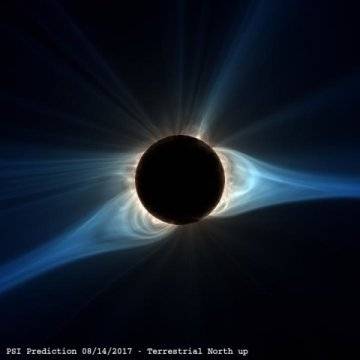21 August 2017 Total Solar Eclipse
21 August 2017 Total Solar Eclipse - Sciences, Education, Art, Writing, UFO - Posted: 20th Aug, 2017 - 5:35pm
21 August 2017 Total Solar Eclipse
Day to night and back again: Earth's ionosphere during the total solar eclipse. Three NASA-funded studies will use the Aug. 21 total solar eclipse as a ready-made experiment, courtesy of nature, to improve our understanding of the ionosphere and its relationship to the Sun. Source 5e.
Image from TACC/Predictive Science, Inc.

21 August 2017 Total Solar Eclipse (Hover)
21 August 2017 Total Solar Eclipse
Spoiler alert: Computer simulations provide preview of upcoming eclipse. Scientists have forecast the corona of the sun during the upcoming eclipse. The findings shed light on what the eclipse of the sun might look like Aug. 21 when it will be visible across much of the US, tracing a 70-mile-wide band across 14 states. Source 5v.
21 August 2017 Total Solar Eclipse
The next one they are saying will be in 2024 so if you miss this one totality you can maybe see it again in about seven years. IF everything comes together correctly. I am unsure where the best viewing of the next one will be. I know the totality of this one is not that far from me.
21 August 2017 Total Solar Eclipse Sciences Education Art Writing & UFO
Eclipse research: Following in the moon's slipstream to capture high-res sunspot images. While much of the research around the eclipse on Monday will focus on the effects of the Sun's brief, daytime disappearance on Earth and its atmosphere, a group of solar physicists will be leveraging the rare event to capture a better glimpse of the star itself. Source 4x.
 TOPIC: 21 August 2017 Total Solar Eclipse
TOPIC: 21 August 2017 Total Solar Eclipse